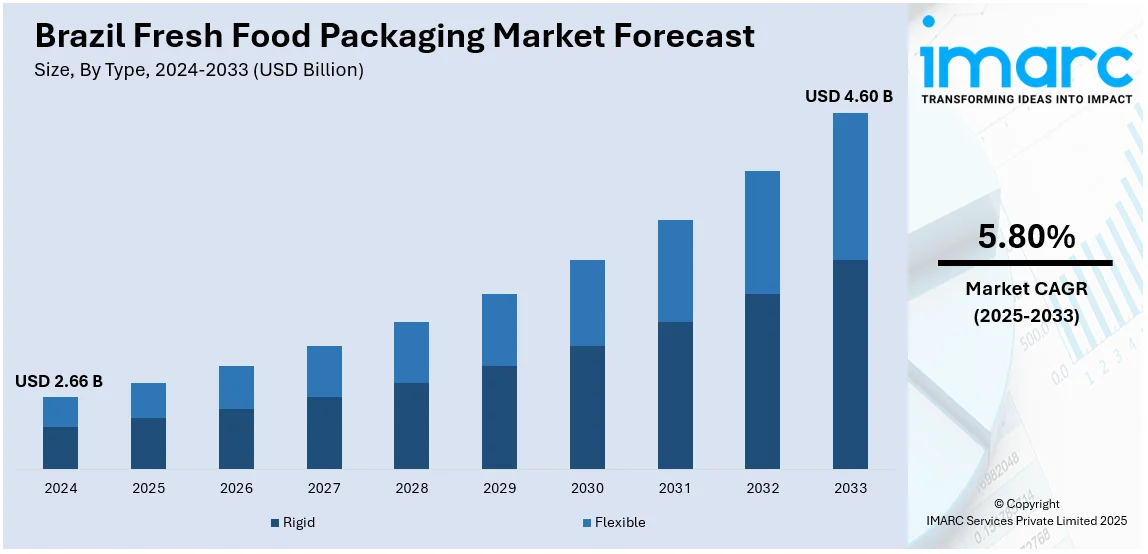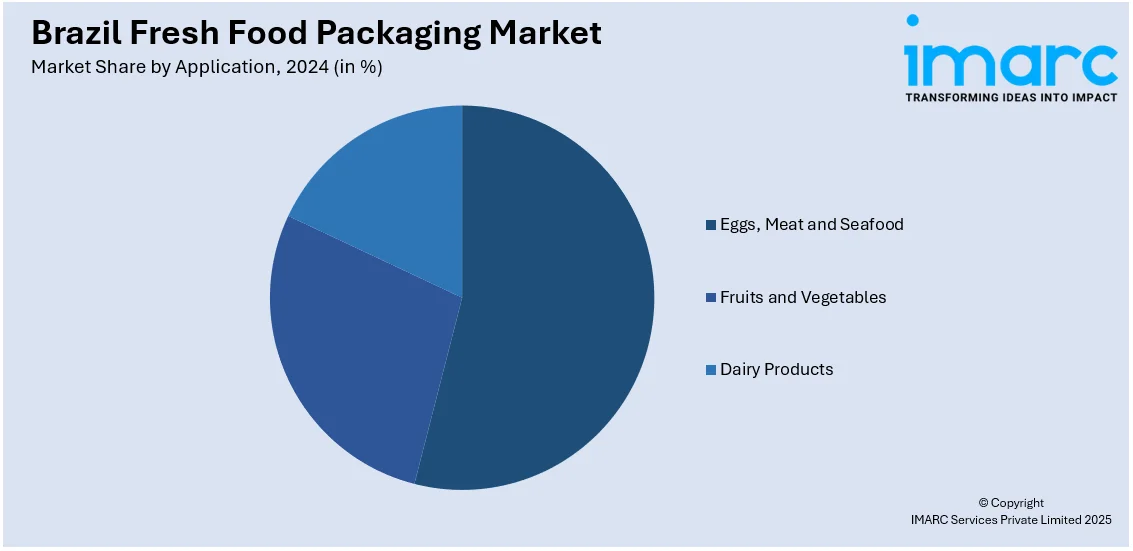
Brazil Fresh Food Packaging Market Size, Share, Trends and Forecast by Type, Material, Application and Region, 2025-2033
Brazil Fresh Food Packaging Market Size and Share:
The Brazil fresh food packaging market size reached USD 2.66 Billion in 2024. Looking forward, IMARC Group expects the market to reach USD 4.60 Billion by 2033, exhibiting a growth rate (CAGR) of 5.80% during 2025-2033. The market is significantly driven by the escalating demand for sustainable solutions, heightening adoption of flexible packaging for convenience and cost-effectiveness, and the proliferation of smart technologies to enhance food safety, traceability, and freshness throughout the supply chain.
|
Report Attribute
|
Key Statistics
|
|---|---|
|
Base Year
|
2024
|
|
Forecast Years
|
2025-2033
|
|
Historical Years
|
2019-2024
|
| Market Size in 2024 | USD 2.66 Billion |
| Market Forecast in 2033 | USD 4.60 Billion |
| Market Growth Rate (2025-2033) | 5.80% |
Brazil Fresh Food Packaging Market Trends:
Increased Demand for Sustainable Solutions
The market is seeing increased need for eco-friendly packaging solutions since consumers and corporations are increasingly concerned about the environmental aspect. The shift in thinking towards biodegradable, recyclable, and compostable packaging is prompted by increased sensitivity regarding plastic waste and its contribution to pollution. Governments' strict laws to limit the use of single-use plastics and encourage environmentally friendly alternatives are accelerating this movement. For example, in September 2024, Brazil produced 7 million tons of plastic, with 44% being single use. The government plans mandatory recycling targets, while companies explore compostable, recycled, and alternative packaging solutions. Moreover, businesses are in turn embracing creative materials like paper-based packaging and plant-based plastics to fulfill customers' demands for sustainability. While consumers and governing agencies are challenging the fresh foods industry to create greener products, growing demand nationwide for sustainable packaging.

Growth in Flexible Packaging Adoption
Brazil's new food packaging market is experiencing growth in the utilization of flexible packaging because it is affordable, portable, and adaptable. Flexible packaging for fresh produce, meat, and dairy products is becoming more popular because of the increasing demand for convenience, particularly in urban areas. This flexible package configuration is gaining high popularity as it offers better external element protection, a longer storage life, and reduced material utilization. In addition, customers and retailers find the flexible packaging to be more attractive because it's easy to carry and transport. Convenience and price benefits will promote a constant shift in the packaging direction to flexible materials with the evolving fresh food industry. For instance, in March 2024, SIG launched spouted pouch packaging in Brazil through a partnership with DPA Brasil, introducing Chamyto yogurt in lightweight, user-friendly packs, enhancing convenience and market presence.
Rising Use of Smart Packaging Technologies
Smart packaging technologies are highly common in the Brazil fresh food packaging industry, as manufacturers and retailers look for means of improving product safety and quality. Such technologies, such as RFID tags, QR codes, and temperature indicators, enable real-time tracking of food freshness and traceability along the supply chain. As consumer pressure for transparency and safety increases, smart packaging presents a means to guarantee that fresh food is protected from farm to table. Driven by continuing technological innovation and amplified emphasis on minimizing food loss, smart packaging is central to maintaining freshness and optimizing logistics.
Brazil Fresh Food Packaging Market Segmentation:
IMARC Group provides an analysis of the key trends in each segment of the market, along with forecasts at the region level for 2025-2033. Our report has categorized the market based on type, material, and application.
Type Insights:
- Rigid
- Flexible
The report has provided a detailed breakup and analysis of the market based on the type. This includes rigid and flexible.
Material Insights:
- Plastic
- Polypropylene
- Polyethylene
- Polystyrene
- Polyvinyl Chloride
- Polyethylene Terephthalate
- Paper and Paper Board
- Bagasse
- Polylactic Acid
- Others
A detailed breakup and analysis of the market based on the material have also been provided in the report. This includes plastic (polypropylene, polyethylene, polystyrene, polyvinyl chloride, polyethylene terephthalate), paper and paper board (bagasse, polylactic acid, others).
Application Insights:

- Eggs, Meat and Seafood
- Fruits and Vegetables
- Dairy Products
The report has provided a detailed breakup and analysis of the market based on the application. This includes eggs, meat and seafood, fruits and vegetables, and dairy products.
Regional Insights:
- Southeast
- South
- Northeast
- North
- Central-West
The report has also provided a comprehensive analysis of all the major regional markets, which include Southeast, South, Northeast, North, and Central-West.
Competitive Landscape:
The market research report has also provided a comprehensive analysis of the competitive landscape. Competitive analysis such as market structure, key player positioning, top winning strategies, competitive dashboard, and company evaluation quadrant has been covered in the report. Also, detailed profiles of all major companies have been provided.
Brazil Fresh Food Packaging Market News:
- December 4, 2023: Sonoco acquired Inapel Embalagens, a Brazilian flexible packaging company, to merge with its current Pinhais operations. Inapel will join forces with Sonoco's subsidiary Graffo Paranaense de Embalagens to increase flexible packaging services. Inapel's former owners will stay as strategic members, contributing to sustainable packaging innovations. This acquisition aligns with Sonoco’s growth strategy and strengthens its presence in the Brazilian market.
- July 17, 2023: From the State University of Campinas's School of Chemical Engineering (FEQ-UNICAMP) and the Packaging Technology Center at the Institute of Food Technology (ITAL), São Paulo, a Brazil-based research team has created a sustainable food packaging film using chitosan and poly(limonene). This novel polymer improves its UV-blocking, antioxidant, and anti-microbial qualities while addressing the problem of plastic waste.
Brazil Fresh Food Packaging Market Report Coverage:
| Report Features | Details |
|---|---|
| Base Year of the Analysis | 2024 |
| Historical Period | 2019-2024 |
| Forecast Period | 2025-2033 |
| Units | Billion USD |
| Scope of the Report |
Exploration of Historical Trends and Market Outlook, Industry Catalysts and Challenges, Segment-Wise Historical and Future Market Assessment:
|
| Types Covered | Rigid, Flexible |
| Materials Covered |
|
| Applications Covered | Eggs, Meat and Seafood, Fruits and Vegetables, Dairy Products |
| Regions Covered | Southeast, South, Northeast, North, Central-West |
| Customization Scope | 10% Free Customization |
| Post-Sale Analyst Support | 10-12 Weeks |
| Delivery Format | PDF and Excel through Email (We can also provide the editable version of the report in PPT/Word format on special request) |
Key Questions Answered in This Report:
- How has the Brazil fresh food packaging market performed so far and how will it perform in the coming years?
- What is the breakup of the Brazil fresh food packaging market on the basis of type?
- What is the breakup of the Brazil fresh food packaging market on the basis of material?
- What is the breakup of the Brazil fresh food packaging market on the basis of application?
- What is the breakup of the Brazil fresh food packaging market on the basis of region?
- What are the various stages in the value chain of the Brazil fresh food packaging market?
- What are the key driving factors and challenges in the Brazil fresh food packaging?
- What is the structure of the Brazil fresh food packaging market and who are the key players?
- What is the degree of competition in the Brazil fresh food packaging market?
Key Benefits for Stakeholders:
- IMARC’s industry report offers a comprehensive quantitative analysis of various market segments, historical and current market trends, market forecasts, and dynamics of the Brazil fresh food packaging market from 2019-2033.
- The research report provides the latest information on the market drivers, challenges, and opportunities in the Brazil fresh food packaging market.
- Porter's five forces analysis assist stakeholders in assessing the impact of new entrants, competitive rivalry, supplier power, buyer power, and the threat of substitution. It helps stakeholders to analyze the level of competition within the Brazil fresh food packaging industry and its attractiveness.
- Competitive landscape allows stakeholders to understand their competitive environment and provides an insight into the current positions of key players in the market.
Need more help?
- Speak to our experienced analysts for insights on the current market scenarios.
- Include additional segments and countries to customize the report as per your requirement.
- Gain an unparalleled competitive advantage in your domain by understanding how to utilize the report and positively impacting your operations and revenue.
- For further assistance, please connect with our analysts.
 Inquire Before Buying
Inquire Before Buying
 Speak to an Analyst
Speak to an Analyst
 Request Brochure
Request Brochure
 Request Customization
Request Customization




.webp)




.webp)












